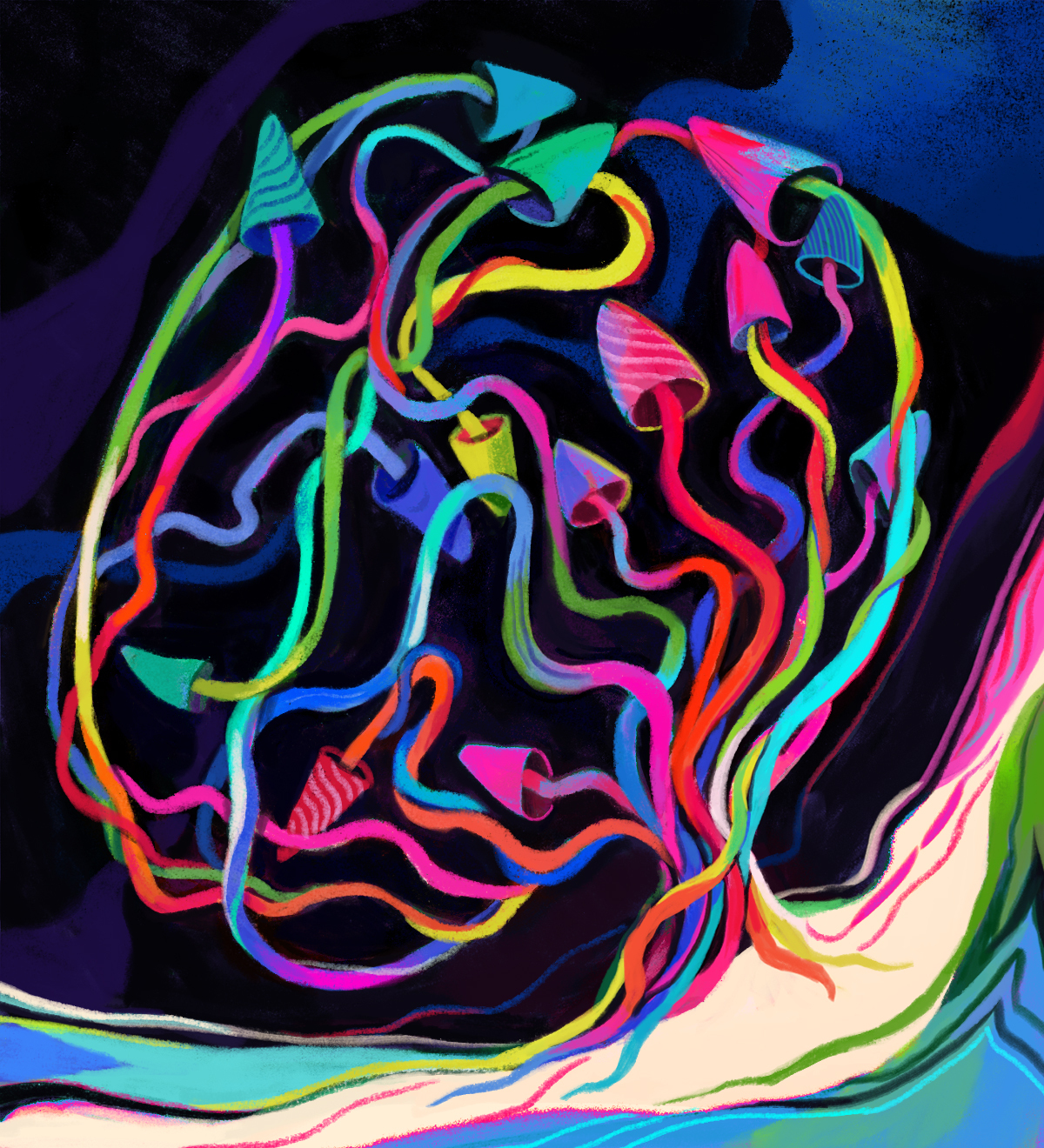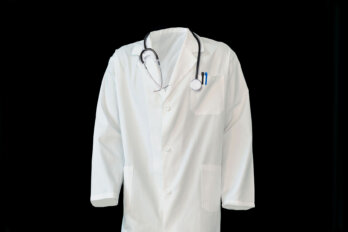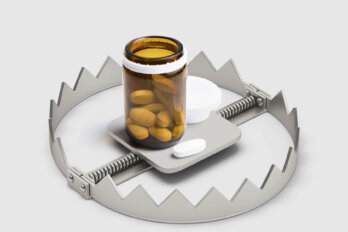Listen to an audio version of this story
For more audio from The Walrus, subscribe to AMI-audio podcasts on iTunes.
Six years ago, on a late fall evening, I stood in front of a pinball machine, flummoxed. The game was space themed, with an elaborate UFO in the middle surrounded by a kaleidoscope of flashing lights. I was mesmerized, but I had no idea how to make it start. The machine’s coin slot and glowing buttons were suddenly indecipherable. Time felt like it had slowed to a crawl, and I became paranoid that the handful of people in the bar were staring at me, wondering what I was doing. It was then I realized that the magic mushrooms were kicking in.
This was the first time I’d taken a hallucinogen since my early twenties. Back then, as a university student, it was a lark. Now, in my forties with a family, the idea was daunting. This trip, however, had a medical purpose: for nearly two decades, I’ve struggled with a rare illness known as cluster headaches. Cluster headaches have been described as more painful than childbirth and kidney stones; they’re sometimes referred to as “suicide headaches” because of the mental toll they take. These headaches happen in groups—for me, they occur two or three times a day for weeks on end. Like migraines, they’re difficult to treat. Over the years, I’ve visited countless neurologists, chiropractors, acupuncturists, and naturopaths. I’ve taken prescriptions and experimented with cleanses and diets. Nothing worked.
Then I stumbled onto Clusterbusters, a popular message board created by a fellow sufferer, where people around the world could swap advice. There was one tip that was gaining traction: multiple posters were reporting that, after they had consumed magic mushrooms, their headaches had abruptly—miraculously—stopped. I was in the midst of a headache cycle at the time and was desperate to stop the pain. I reached out to a long-time friend in Toronto, and not long afterward, we downed a handful of dry, fishy-tasting fungi in his newly renovated kitchen.
The mushrooms kicked in about an hour later, at that bar on Dundas Street. My recollection of the rest of the night is fuzzy: we eventually managed to play some pinball (badly), then we left the bar to wander around Bloor West Village, which to my eyes appeared as a Tolkienesque landscape filled with quaint gingerbread houses. The trip lasted about six hours, after which I collapsed into bed. When I woke the next morning, I felt different: the mental fog brought on by my cluster headaches was gone. For the next twelve months, I remained headache free. Every year since, I’ve downed a dose of shrooms, and every year my cluster headaches have remained in remission.
My experience may be anecdotal, but it isn’t unique. Numerous recent studies have shown the potential medical benefits of psilocybin, the psychoactive ingredient found in these mushrooms. In clinical trials, psilocybin has been used to successfully treat drug addiction, PTSD, severe depression, and, yes, cluster headaches. For sufferers of certain hard-to-fix illnesses, psilocybin now offers a rare glimmer of hope. The catch, of course, is that the substance has long been illegal in Canada—and most other countries too. Pressure is now growing to decriminalize magic mushrooms for medical purposes, much like with medical marijuana twenty years ago. But movement has been slow as questions persist about how exactly psilocybin works on the body and mind and the risks associated with it.
Humans have been ingesting psilocybin mushrooms for centuries if not longer. There are more than 180 species, with names like Liberty Caps (the most widespread), Philosopher’s Stones (said to be nausea inducing), and Flying Saucers (a particularly powerful strain). Across the Americas, Indigenous peoples have long used mushrooms for spiritual communions and healing ceremonies. In the mid-1950s, Americans began trekking to Mexico in search of the so-called sacred mushroom. Scientists, too, became interested in the fungi’s medicinal properties. In 1960, the Harvard Psilocybin Project, led by Timothy Leary, launched to explore the drug’s psychological benefits. But the academic interest was short-lived: within a decade, growing political concerns over LSD and other psychedelics led to a crackdown, and research programs were largely shuttered.
It’s only in the past several years that interest in psilocybin has crept back from the fringes. Spurred on by the acceptance of cannabis and ketamine for medical uses, research in psilocybin has ramped up, fuelled in part by private funding. Several Canadian clinics have recently been granted permission to conduct trials for treating substance addiction and depression, including BC-based Numinus, which last year completed the first legal harvest of psilocybin mushrooms in Canada for the purpose of medical testing. Others, like private UK health care startup Compass Pathways, have attracted star investors, including early Facebook backer Peter Thiel. “Psychedelics Replace Pot as the New Favorite Edgy Investment,” proclaimed a Bloomberg headline last year.
Of all the potential medical uses, the treatment of severe depression appears most promising. A paper recently published by Johns Hopkins University, for example, reported that two doses of psilocybin, given with supportive psychotherapy, produced rapid and large reductions in depressive symptoms. “The magnitude of the effect we saw was about four times larger than what clinical trials have shown for traditional antidepressants on the market,” announced Alan Davis, one of the researchers, in a media release. Other researchers have reported that a single dose of magic mushrooms can increase a person’s level of spirituality, willingness to forgive, and connectedness with others—all traits associated with a happier, more meaningful life.
Still, it’s not entirely clear how psilocybin works. The benefits seem related to the “mystical experience” produced by the drug—a hallucinatory state in which a person’s sense of self melts away. It’s a process akin to hitting a reset button on the brain, sometimes referred to as “ego death.” “With a psychedelic, it is more about a release of thought and feeling that, when guided with psychotherapy, produces positive outcomes,” Robin Carhart-Harris, head of the centre for psychedelic research at Imperial College London, told the Guardian. Participants in an Imperial College London study who were given psilocybin often reported feeling that they had gotten more to the root of why they were depressed, Carhart-Harris said.
Research on the drug’s effects on cluster headaches is more nascent. Yale University began studying psilocybin’s effects on the illness five years ago, inspired in part by anecdotal reports on Clusterbusters. Sixteen sufferers were screened for physical and mental health concerns and asked to begin tracking their headaches in a journal. A few weeks later, they were given either a low or high dose of psilocybin or a placebo. The results have not yet been published, but researcher Emmanuelle Schindler, assistant professor of neurology at Yale’s school of medicine, tells me that they look promising. “It’s a proof-of-concept study that sort of confirms, in a randomized controlled way, what patients have been talking about for many years,” she says.
Part of the purpose of clinical testing, Schindler explains, is to better understand a drug’s side effects. With psilocybin, patients may feel nauseous or tingly or, at high doses, have hallucinatory experiences—but none of these are unexpected, she says. Nor do they necessarily pose risks provided that the patients are being closely monitored. “As long as you have all the safety precautions and approvals in place, I don’t see [psilocybin] as that much different from studying any other drug,” Schindler says. “I think people are starting to realize that too.” Still, for new researchers, gaining approval to do clinical testing with psilocybin “can be challenging,” she says. The negative cultural baggage long attached to psychedelics persists.
The only approved use of psilocybin in Canada today is for end-of-life care. Last year, Bruce Tobin, a psychologist and clinical counsellor based in Victoria, was one of the first doctors to be granted such an exemption under the Controlled Drugs and Substances Act. His patient had received a diagnosis of terminal cancer and fallen into a deep, seemingly untreatable depression. “She had tried a wide range of pharmacological agents and a number of therapists and different forms of talk therapy,” Tobin says. “Nothing was sufficient to alleviate her end-of-life distress.” In 2017, after reading about promising trials done elsewhere, Tobin embarked on a legal challenge to the federal government to treat his patient with psilocybin. He cited an earlier Supreme Court case that allowed access to medical marijuana as a right under the Canadian Charter of Rights and Freedoms.
After three years of legal wrangling, Tobin was granted permission to treat his patient with a five-milligram dose—a little less than the amount that typically causes a hallucinogenic experience—in his clinic. “It was a very difficult experience for her,” he says. “There was a great deal of crying and grieving and trembling. And yet, by the end of her session, she had come to a place of real peace and acceptance for what had befallen her.” The patient underwent talk therapy before and after the psilocybin treatment, Tobin says, and her depression improved dramatically as a result. Since then, the federal government has granted exemptions for thirty-four terminally ill patients and nineteen doctors. But Tobin says that demand for psilocybin is outstripping the pace of approvals. “We’re essentially denying dying people their final request for comfort.”
There are obvious parallels between magic mushrooms and cannabis, which Canada approved for medical use in 2001 and decriminalized in 2018. But there are notable differences too. Simply put, nibbling on a cannabis-laced gummy bear is one thing; ingesting a handful of magic mushrooms and embarking on a six-hour hallucinogenic trip is another. “If the setting or the circumstances are not skilfully managed, then there’s potential for harm,” says Mark Haden, author of Manual for Psychedelic Guides and director of clinical research at Psygen Labs, a Canadian company aiming to manufacture pharmaceutical-grade psychedelic drugs. Haden is a strong proponent of psychedelics for medical treatment, but he also acknowledges the risk of patients being taken advantage of while under the influence of a hallucinogen—or of them not being properly guided through an intense experience. “Psychedelics are unconscious amplifiers, and people will go to their dark places,” he says. While there is no evidence that psychedelics can cause mental illnesses, researchers recommend that people who have a personal or family history of psychosis disorders avoid taking them. Haden also stresses the importance of training professionals, as well as patients, before a hallucinogenic session. “When you’re lying on the couch, you need somebody to be there for you, radiating stability and support and allowing you to go to that place,” he says. Likewise, Haden supports legalizing psilocybin but argues that it should be restricted to individuals who have completed training and testing.
Two years ago, Tobin founded a nonprofit called TheraPsil to advocate for legalizing psilocybin for end-of-life care. TheraPsil submitted draft regulations to Health Canada earlier this year, detailing how psilocybin should be prescribed and purchased as well as how the quality of the drug should be standardized. It based its submission on similar regulations the federal government created in 2016 for medical marijuana. Tobin is cautiously optimistic that regulations for psilocybin will be in place within the next year or two. He points to recent polling suggesting that the majority of Canadians support the use of the drug for end-of-life treatment. Other polls have found support for its decriminalization in a handful of US cities and states. “We’re going to look back and realize that we were in the Dark Ages,” Tobin says.
Legalization for cluster headache sufferers like me seems further off. When I asked Schindler how long she thought it would take for psilocybin to become an approved headache treatment in the US, she suggested several years minimum, assuming the next phases of clinical trials are successful. “There is a lot more research that needs to be done,” she said.
It was a bit deflating to hear this. Last fall, after the pandemic hit, I wasn’t able to visit my friend in Toronto to take my dose (an experience we’ve come to refer to as our “annual pilgrimage”). So I wasn’t surprised when, late last November, my cluster headaches returned for the first time in years. I gobbled down ineffective migraine medication as I rode out the headaches—several times a day for nearly two months. It was frustrating, stressful, and—more than anything else—painful. The experience was made all the worse knowing that, if I’d only had access to a few grams of dried mushrooms, there’s a good chance it wouldn’t have happened at all.
Correction January 7, 2022: An earlier version of this article stated that Bruce Tobin was granted an exemption under the Controlled Substances Act. In fact, he was granted an exemption under the Controlled Drugs and Substances Act. The Walrus regrets the error.





